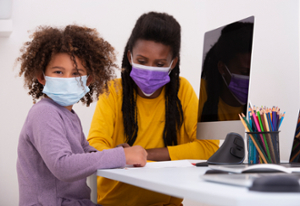SRNT 2021 Symposium: Tobacco Use as A Risk Factor for Infection with COVID-19 Virus
At the 2021 annual meeting of the Society for Research on Nicotine and Tobacco (SRNT), three TRDRP grantees presented their research at the intersection of tobacco use and COVID-19. The individual talks by Drs. Holly Middlekauff, Brigitte Gomperts and Jiang Li are posted below.
Following the three presentations, TRDRP grantee Matthew Springer, PhD, from UCSF moderated a discussion with the panelists. A brief description of some of the topics covered during the discussion are listed below as well.
Background
The response to infection with SARS-CoV-2, the virus that causes COVID-19, varies widely among individuals. Smoking is known to impair lung function, thereby increasing the severity of respiratory infections in general. Consistent with this fact, studies suggest that hospitalized COVID-19 patients who smoke are at higher risk of developing severe outcomes or death than non-smokers, but how smoking and other forms of tobacco use affect the risk of infection in the first place is still unclear. In their talks, the presenters describe molecular, cellular, and epidemiological studies that address this question.
Presentations
Differential Expression of Immune Cell Instigators of COVID-19 in Tobacco Cigarette Smokers and Electronic Cigarette Vapers
Holly R. Middlekauff, MD
Department of Medicine, David Geffen School of Medicine at UCLA, Los Angeles, California
Dr. Holly Middlekauff describes her lab’s findings on protein changes observed in immune cells collected from healthy smokers and vapers before the pandemic. As compared to non-smokers, smokers showed significant increases in angiotensin converting enzyme 2 (ACE2) and other human host proteins with critical roles in SARS-CoV-2 infection and virulence, while vapers showed only minor changes.
Discussion: The SARS-CoV-2 receptor ACE2 has a normal function, which is beneficial to the body in various ways. This raises the question whether upregulation of ACE2 by smoking not only increases the ability of SARS-CoV-2 to enter cells, but also has beneficial effects. This is likely not the case though, because binding of the virus to the ACE2 molecule on cell surfaces leads to what is called internalization of ACE2, removing it from the cell surface and obviating its potential beneficial effects.
Direct Exposure to Sars-Cov-2 And Cigarette Smoke Alters the Stem Cell Derived Airway Repair Response and Increases Infection Severity
Brigitte N. Gomperts, MD
University of California, Los Angeles
Dr. Brigitte Gomperts discusses the effects of cigarette smoke exposure on susceptibility to SARS-CoV-2 infection in human airway cells grown in culture. Smoke exposure led to an increase in infected cells, which could be explained by a lack of SARS-CoV-2-induced interferon response.
Discussion: The human airway cells in culture can also be used to study the effects of vaping. One of the challenges of studying the health effects of vaping lies in the very large number of flavors (thousands) offered in vape juices. Dr. Gomperts’ group has already initiated studies to look at the effects of aerosols containing nicotine and the vape constituents propylene glycol and vegetable glycerin, but this system lends itself to high throughput studies, and the lab is in the process of identifying potentially toxic effects of individual flavors on airway cells.
The Impact of Smoking, Comorbidities, and Race/Ethnicity on COVID-19 Infection
Jiang Li, PhD
Sutter Health Center for Health Systems Research/Palo Alto Medical Foundation Research Institute
The studies described by Drs. Middlekauff and Gomperts provide important molecular evidence of how smoking may worsen SARS-CoV-2 infectivity and disease severity. To complement these mechanistic studies, Dr. Jiang Li describes her epidemiological analyses, determining whether and to what extent active and passive smoking, comorbidities, and race/ethnicity are associated with SARS-CoV-2 infection, using electronic health records data collected from a large healthcare system in northern and central California. Passive smokers as well as older patients, males, Hispanic/Latino patients, and patients with more severe comorbidities are at increased risk for testing positive for SARS-CoV-2.
Discussion: A surprising finding of Dr. Li’s study is that secondhand smoke (passive smoking), but not smoking itself, seemed to increase the risk of testing positive for SARS-CoV-2. Possible explanations discussed included the idea that smokers may benefit from possible positive effects of nicotine, whose concentration is much reduced in secondhand smoke, while leaving behind the more toxic components of smoke. Another factor that may be at play is that SARS-CoV-2-infected smokers may cause higher virus levels in surrounding air than non-smokers do, since smokers exhale more forcefully than non-smokers, and are more prone to coughing. This could increase the SARS-CoV-2 infection risk for passive smokers.
Overall, the panel concluded that there are many current studies using a variety of interesting approaches to better understand the intersection of tobacco use and COVID-19 disease. This is a complex problem with diverging outcomes so far, and a large, well-controlled prospective study is needed to definitively establish what links exist between COVID-19 disease and tobacco use. Establishing the effects of smoking marijuana on COVID-19 disease is also of great interest. This kind of information would be of great value for the next pandemic.

